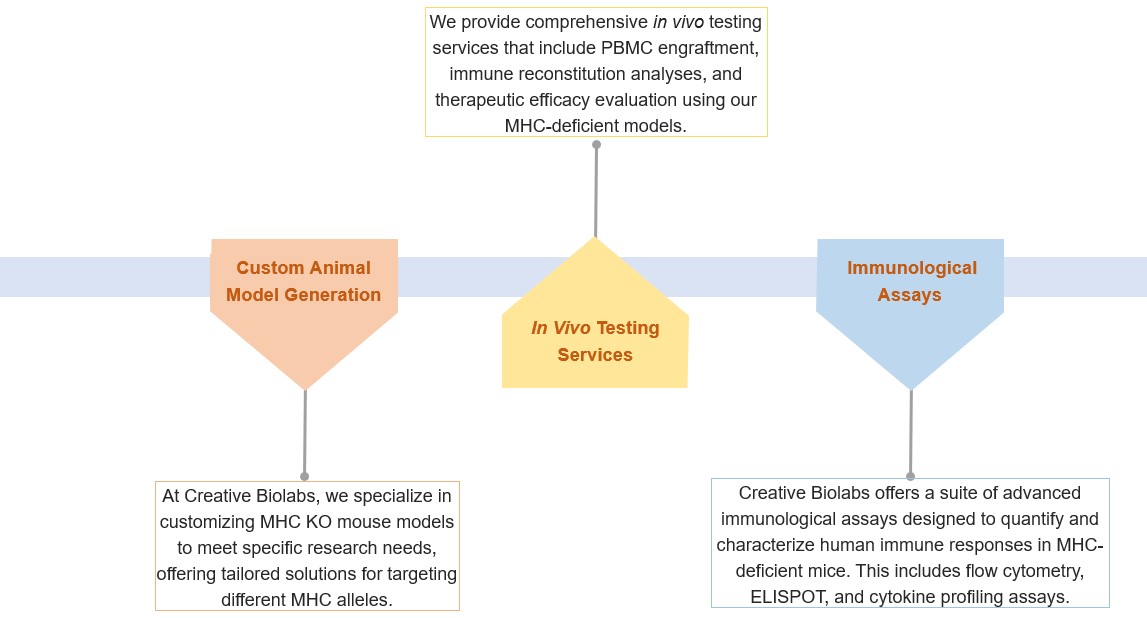Human PBMC-MHC KO Mouse Model for Immuno-Oncology Study
Introduction
Innovations in immuno-oncology research have necessitated the development of sophisticated in vivo models. Among these, the human PBMC-MHC KO mouse model stands out as a significant advance. These models allow researchers to meticulously investigate human immune responses in the context of cancer and other immunological diseases. Creative Biolabs has been at the forefront of developing and utilizing these models, providing detailed insights and accelerating the pace of novel therapeutic interventions.
Human PBMC-MHC KO Mouse Model for Immuno-Oncology Study
The conventional challenge with reconstituting human peripheral blood mononuclear cells (PBMCs) into immunodeficient mice, such as NOG or NSG strains, is the onset of severe graft-versus-host disease (GvHD). This acute immune reaction, driven by the interaction of human T cell receptors (TCRs) with murine major histocompatibility complex (MHC) proteins, significantly limits the lifespan of the animal models and the window for evaluating human immune cell functions.
To address this limitation, Creative Biolabs has developed MHC class I and II double knockout (dKO) mouse models. These novel models eliminate murine MHC molecules, thus mitigating the risk of GvHD and facilitating longer and more accurate assessments of human immune responses in vivo. Advanced technology has been used for successfully knocking out the H2-K1, H2-D1, and H2-Ab1 genes, creating a truly innovative platform for cancer immunotherapy research.
Versatile Applications
-
Extended Experimentation Window
The MHC dKO models allow for prolonged study durations due to the significant reduction in GvHD symptoms. This extended window is critical for monitoring chronic responses and the long-term efficacy of immunotherapies.
-
Human Immune Cell Reconstitution
The PBMC-MHC KO models serve as an excellent platform for studying human immune cell behaviors and their interactions with various antigens. Engrafted immunocytes, including T cells, B cells, NK cells, and dendritic cells (DCs), can be tracked over extended periods, providing more multifaceted insights.
-
Pharmacodynamic and Pharmacokinetic Studies
These models prove invaluable for evaluating the pharmacodynamics and pharmacokinetics of novel immunotherapeutic agents. The normal FcRn function retained in our MHC KO strains ensures accurate results for antibody metabolism studies, essential for preclinical testing of therapeutic antibodies and CAR-T cells.
The PBMC reconstituted MHC KO mouse models are highly instrumental in assessing the anti-tumor efficacy of T cell receptor-engineered therapies, such as those targeting melanoma-associated antigen MART-1.
Our Related Services

Features of Our Human PBMC-MHC KO Mouse Model
-
Advanced Genetic Engineering: Utilizing cutting-edge knock-out technology for precise knockout of MHC class I and II genes.
-
Extended Lifespan: Significantly reduced GvHD extends the lifespan of the models, allowing for long-term studies.
-
Normal FcRn Function: Retained FcRn-mediated antibody metabolism facilitates accurate pharmacokinetic evaluations.
-
High-Fidelity Reconstitution: Effective engraftment of human PBMCs with robust immune cell reconstitution and minimized donor-to-donor variability.
-
Versatility: Suitable for a wide range of applications, from basic immunological research to advanced preclinical testing of immunotherapies.
Frequently Asked Questions
Q1: How does the MHC KO model reduce GvHD?
A1: By eliminating MHC class I and II molecules, the interaction that triggers GvHD is minimized. This allows the human PBMCs to persist and function in the mouse model without inducing a severe immune response.
Q2: Can these models be used for studies beyond cancer immunotherapy?
A2: Absolutely. These models are highly versatile and can be applied to various fields including infectious diseases, autoimmune disorders, and transplantation research.
Creative Biolabs remains committed to advancing immuno-oncology research through innovative and high-quality animal models, fostering breakthroughs in our understanding and treatment of cancer and immunological diseases.
For Research Use Only | Not For Clinical Use



 Download our brochure
Download our brochure